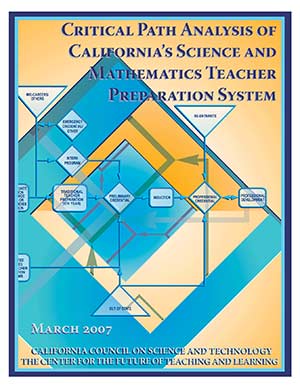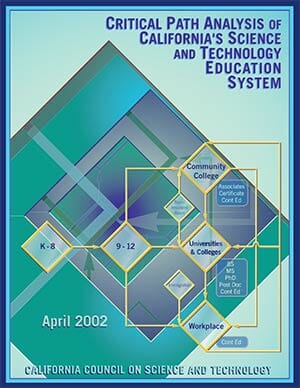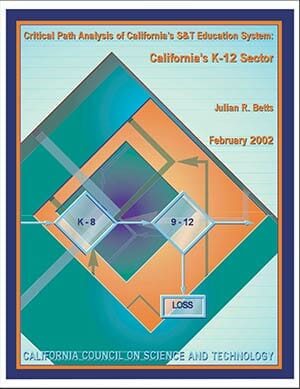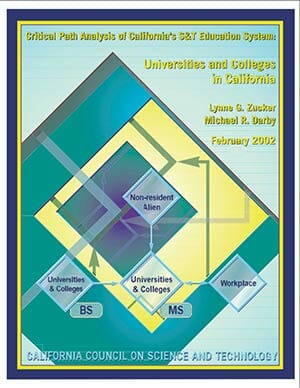Critical Path Analysis of California’s Science and Mathematics Teacher Preparation System
Author(s): Riordan, Donna Gerardi; DeCillis, M. Daniel
Release Date: March 5, 2007 | Last Updated Date: March 5, 2007
Abstract
This report follows on the work of the 2002 Critical Path Analysis of California’s Science and Technology Education System. It provides an overall analysis of the preparation, retention, and professional development of science and mathematics teachers in California. The project was conducted in collaboration with the Center for the Future of Teaching and Learning; major funding was provided by the Stuart Foundation, with additional support provided by Cal Poly, Pomona; Cal Poly, San Luis Obispo; CSU Fresno; CSU Fullerton; CSU Los Angeles; and CSU Northridge.
The report reveals that more than ten percent of all math and science teachers are underprepared, meaning they lack the training and experience necessary for a teaching credential in the subject they teach. More than one third of novice teachers (those in their first or second year) teaching math or science are underprepared. At the current rate of teacher preparation, California will fall short by 30 percent of the fully prepared math and science teachers needed by California schools. Citing recent data projecting significant declines in personal income and a low rate of STEM degrees produced in California, the report concludes that strengthening the teaching of mathematics and science is critical if California is to maintain its competitive edge and economic growth.
Recommendations:
State-wide Education Leadership and Policy Organizations
- Establish public-private partnerships with industry and business in the areas of science and mathematics to actively recruit retiring professionals to the classroom as mentors.
- Reinstate the Mathematics and Science Summer Institutes offered through the California Subject Matter Projects. Also provide a one-time planning grant for California Subject Matter Project personnel to design and implement just-in-time professional development opportunities.
- Fully fund the new California Longitudinal Teacher Integrated Data System (CALTIDES) to gather and analyze data and report annually on:
- the supply and demand of science and mathematics teachers in elementary and secondary schools.
- the production of single-subject science and mathematics credentials, by field and institution.
- the numbers of single-subject science and mathematics credentials awarded by institution and type of teacher-preparation program
- Implement the Memorandum of Understanding (MOU) between the California Community Colleges and the California State University to create a streamlined and strengthened pathway for aspiring teachers; coordinate MOU activities with the University of California’s program to develop new pathways into the teaching profession by identifying community college students interested in both STEM fields and teaching.
- As part of the monitoring implementation of SB 1209 and SB 1133, review during budget hearings the extent to which fully prepared science and mathematics teachers are distributed evenly throughout participating school districts.
Institutions of Higher Education (IHE)
- Determine how current teacher-prep programs can be expanded to produce more single-subject science and mathematics teachers. Ensure that all elementary school teachers are prepared to teach science and mathematics.
- Expand exemplary California Academic Partnership Programs as a means of encouraging IHE campuses to work collaboratively with school districts to ensure that teachers delivered to the classroom are well prepared and supported as new teachers, in both content and pedagogy.
School Districts
- Use the new Mentor Teacher Support Program established in SB 1209 to offer support for all science and mathematics intern teachers and coordinate this program with the district’s existing Beginning Teacher Support and Assessment (BTSA) program. Fund the California Subject Matter Projects and other professional development organizations to provide training for mentor teachers.
- Utilize the new professional development block grant funding and resources available to identified schools in SB 1133 to design and implement coordinated, cohesive, coherent professional development programs throughout the districts.
- Develop incentive-pay systems to encourage teachers to take assignments in shortage areas and attract them to high-need schools.
Industry, Federal Laboratories, and Informal Science Learning Centers
- Expand support for professional development of science and mathematics teachers. In particular, provide authentic research and work experiences, especially during the summer months, and build on successful work experience models that integrate the learning of new content with teaching strategies.







